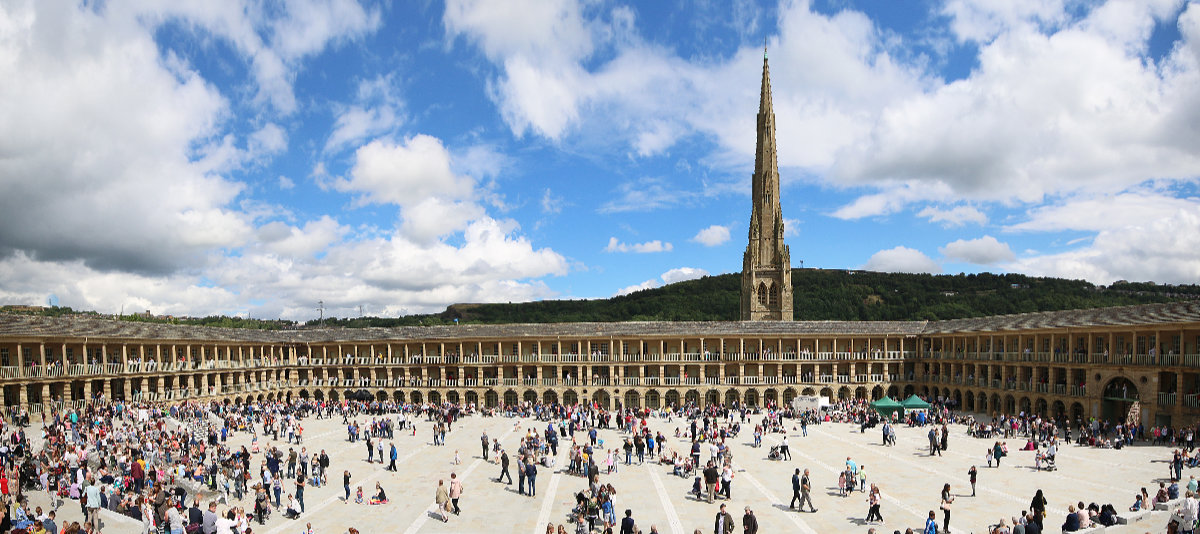
Halifax a historic town with a bank named after it.
Visiting the Calder Valley but looking for a place with the big town amenities while still keeping that historic feel? Well, look no further than Halifax, by far the biggest population centre in the constituency and one steeped in history, dating back over 900 years. The town that went from being largely overlooked in the Doomsday Book to an industrial revolution boomtown in the 19th century, and then having to reinvent its self in for the 21st Century.
Whatever your interest Halifax has something to offer, visitor sites & landmarks, check, interesting historical occurrences, check, Shopping Centres, check. You get the picture. It even has a couple of sporting teams of some note and a canal which you can stroll along and let your cares slip away, at least for an hour or two.

Image: Lenscap Photography/Shutterstock.com
Anyway now we have whet your appetite let’s take a more detailed look at the town starting where we always start with a little bit of history. We know you are dying to find out how a town become so famous that they name a building society (now a Bank) after it!
Early Halifax History
It is likely that the area now comprising Halifax has been occupied since ancient times. However the first possible reference to the actual town dates from 1091 as a settlement named Halyfax, a name possibly derived from the Olde English for an area of coarse grass set in the nook of the land (you have to love the Olde English brevity).
Prior to that, it was part of the Manor of Wakefield and likely had some habitation and possibly a church. However, we couldn’t find any reference to it being catalogued in the Doomsday Book (via the Open Doomsday Project) despite some sources quoting it as being referred to as Feslei?
We couldn’t find that either so if you can enlighten us further please get in touch.
Whatever by the 12th century, the Halifax area was steadily growing and had become the go-to religious centre for much of Yorkshire, with parts of what is now Halifax Minster having been built then. Cloth & weaving soon became a major industry with easy access fo wool from the hill sheep and by the 14th Century, Halifax was Yorkshires leading Kersey manufacturer.
The Plague Hits Halifax
Around this time the Black Death struck the area and the great plague of 1346–1353 reportedly destroyed around a third of the town’s population. A population loss of this magnitude could have devastated the area, but fortunately, the problems occurring in mainland Europe at the time meant that there was soon an influx of people seeking a safe haven.
What is now Halifax Minster was further enlarged during this time, reflecting the prosperity of the town and by 1475 the town was booming with the Halifax market selling as much as five times the cloth sold in Leeds! In fact, Halifax would hold on to its position as the major cloth producer in Yorkshire for another couple of hundred years.
The Rise of The Domestic Weaver
By the 1500s the West Riding of Yorkshire led by Halifax was Englands third-largest cloth producing region (behind Esat Anglia & the South West) and this grew further thanks to the “Halifax Act of 1555, which for the first time removed the need for people to buy and sell wool through a “Middleman” thus removing the barriers to entry for home weavers. Although it was called the Halifax Act, it applied to the whole parish, then some 120 square miles. This domestic production not only increased output massively but also increased the prosperity of the population, who were at a disadvantage given that the hilly locale was not ideal for agriculture generally.
Watch out for the Halifax Gibbet
Not everything was great about Halifax in the 1500s & the 1600s though and the town was somewhat infamous around this time thanks to its draconian treatment of anyone who had the audacity to steal the precious Kersey cloth, or anything else worthy over 13 1/2d (around 6p today and probably less than £10 in comparative purchasing power).
Unlike most towns and cities Halifax retained the right to execute petty criminals right up until Oliver Cromwell stopped in in 1650 and between 1538 and that date 56 men and women met their grizzly end at the hands of the Gibbet. We can sort of see why they needed to have a strict policy as all of the cloth made had to be dried in the open air and was thus vulnerable to theft, however, this took draconian law to the extreme.
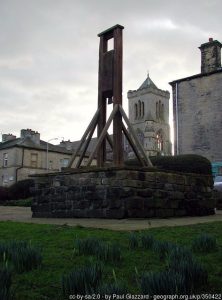
A replica of the infamous Gibbet is still on display in the town – possibly as a warning to would-be shoplifters?
A Day Out!
What made it even more repugnant (other than an execution being viewed as an exciting day out for the locals) was the fact that for some reason no one ever bothered to sharpen the blade hence in the later years the poor victim literally had their necks crushed and head ripped off! Given there were no official records kept in the parish pre this date can’t quantify how many people met this horror filmesque end this way however it is thought to be north of 100. We have added a couple of macabre facts regarding this in our fun (or not so fun trivia section below).
The English Civil War
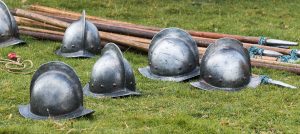
Image: Peter F. R. Forster/Shutterstock.com
The 17th Century began peaceably enough for Halifax (if you exclude the occasional gibbeting) however by 1642 life changed in the town thanks to the English Civil War which ended well for all the Yorkshire Textile towns but not before they suffered some strife. As one can imagine at that time Halifax was prosperous but more working-class than gentile and so they threw their lot in with the Parliamentarians. Not a good move in the early days of the conflict as after the battle of Adwalton went the Royalists’ way on the 30 June 1643, the Parliamentarian soldiers abandoned Halifax and headed back into the relative safety of Lancashire.
On 28 January 1644 Royalist troops led by Major General Sir Francis Mackworth took control of the town and as you can imagine they were not too friendly towards those who had supported Parliament. Many fled the Calder valley as a whole seeking refuge in the nearest Lancashire towns.
Charles I Has A Bad Day
Anyway fast forward to 30 January 1649 when Charles I loses the head – literally and Parliament is in charge and they are quick to recognise those who supported them. Halifax is on the move again and now it’s not just Wool and Kersey, tanners, shoemakers and glovers are all now present and the population is booming as it serves as the commerce focal point for the Calder Valley.
But it was cloth and clothing which continued to spur Halifax’s growth and as the countries population continued to grow, so did the eminence of the “Northern Wool Towns” as the people needed clothes and most depended on the cheaper Kersy that Halifax was famous for. This exponential growth would continue for most of the 1700s.
The Industrial Revolution
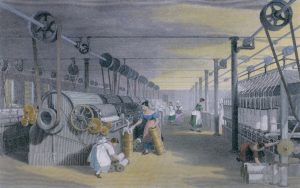
Image: Everett Collection/Shutterstock.com
The dawn of the 19th Century saw a move away from the traditional small scale handloom weaving as factories began to take over and although the Luddites did there best to slow the process, pretty soon textile factories and increasingly cotton cloth began to become the major output. This didn’t slow the growth of the town which had expanded from around 6000 inhabitants in 1750 to around 9,000 by 1800 but instead changed the culture away from a more artesian approach to a more regimented one.
It also made a few super-rich while still, by and large, benefitting the majority. Soon the town was dominated by huge mills (many now gone) as carpet making and cotton cloth began to expand and with it replacing to a degree the more traditional emphasis on wool.
Here Comes The Train!
The arrival of a rail link on 1st July 1844 provided another huge boost to the town connecting it to Manchester a move which boosted trade significantly and six years later the town was connected to Bradford. The popularity of rail travel led to new station buildings being constructed in 1855 and this was enlarged and revamped further in 1886.
Sweets anyone?
The second half of the 19th Century saw exceptional growth and soon the nearby settlements of Haley Hill, King Cross & Mount Pellon were absorbed into the growing urban conurbation as construction not only of mills but also housing continued unabated. The latter helped in no small way by the arrival of the Halifax Equitable Benefit Building Society in 1871 (now HBOS) which helped its members get on the residential property ladder. The town hall was built in 1863 and in 1874 the Wainhouse tower was finished standing 275 feet and then the worlds tallest. The town even had a sweet side thanks to the founding of Mackintoshes in 1890.
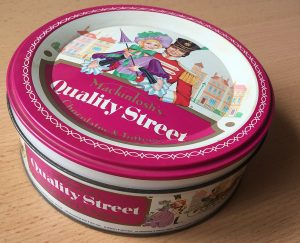
This iconic Christmas treat was launched in 1936.
Image: KarleHorn / CC BY 3.0
Everything was booming and by 1891 the census listed the population of the town at 97,714 a quite staggering increase over 90 years! This growth was to continue up until the advent of WWI with the 1901 figure being 104,936.
20th Century Halifax
The decline in the town’s fortune began in earnest in 1914 with the outbreak of war, but not directly due to the conflict although it did take its toll on the Yorkshire Regiment. Up until WW1 Britain and the northern textile towns, in particular, remained preeminent exporters of cloth, however, the war years meant that this stopped. This forced countries that had previously been dependent on UK imports of textiles (cotton based in particular) to set up their own factories.
This sowed the seeds of decline and by 1933 Japan had become the world’s largest cotton manufacturer, which had a devastating impact on exports. It is estimated that around 800 UK cotton mills closed between the two world wars, many in Halifax, and the textile industry never recovered.
Still, things were not all doom and gloom as John Mackintosh & Sons Ltd who was still based in the town floated on the stock exchange in March 1921 and went on to become an international brand launching such confectionary staples as Quality Street in 1936 and Rolo in 1938. Who said all that Halifax could make was textiles!
The Mills Start To Close
Anyway, you can’t base a towns fortune on sweets alone and as the 1950s wore on more and more mills closed leaving behind empty shells which became derelict. Even Mackintosh disappeared after merging with Rowntrees in 1969. Manufacturing UK wide went into a speedy decline throughout the 1970s falling from 30.1% of GDP in 1970 to 22.3% by 1981 and with much of the town’s economy being involved in this, even the population went into decline.
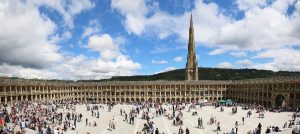
Piece Hall once a fabric market but now filled with Boutique shops.
Image: Alastair Wallace/Shutterstock.com
The 1990s Revival
Fortunately from the 1990s onwards, things have been on the up and Halifax is something of a model of regeneration with many of the old mills now being upmarket apartments. Success stories include the revitalisation of Dean Clough Mills once one of the worlds the largest carpet factories from a disused site in the early 1980s into a modern complex comprising offices, galleries, bars and restaurants. There are probably more people employed here now than when it was at its peak as a carpet maker!
Also of note is the transformation of Piece Hall – once one of the countries main fabric trading centres, this Grade 1 Listed Building is now a showpiece central piazza offering an open-air cultural venue and shopping destination. So although the town’s population may only be around 84% of its 1901 level (88,134 at the last census) it is now a great place to live or visit.
So now you have a bit of a background on the town how about a bit of trivia? Well everyone loves a bit of trivia, don’t they?
Fun (and Not So Fun) Facts About Halifax!
Well after all that research we decided to have a time out and compile some of the funniest, not so funny and interesting, that we found out about Halifax (well we think they are interesting). So without further ado here are some of the Five Minutes Spare favourites:
- William Herschel was also the first person to play the organ at Halifax Minster (then St John the Baptist church). He also discovered Uranus in 1781 but had upped sticks and moved to Bath by then.
- On Tuesday June 17 1913 Halifax Yorkshire could have been mistaken for Halifax Nova Scotia briefly after a Canadian Grizzly Bear escaped from the now closed Halifax Zoo and went for a stroll down Jubilee Road much to the annoyance of the locals. It remained at large for a couple of hours before being captured. Its compatriot a Russian Bear escaped its enclosure at the same time but didn’t make it out of the Zoo.
- Halifax Town Hall and the Houses of Parliament were designed by the same architect. Charles Barry who had a flair for the gothic.
- The Wainhouse Tower has 403 steps and was, at the time of construction, the tallest tower in the world!
- Halifax Minster the Grade I listed only achieved such status recently. From the 1400s when it was built until 2009 it was known as the Church of St John the Baptist.
Anyway now on to the trivia, you have been waiting for The Gibbet. Well, we all like a bit of macabre stuff!
- The Gibbet Law being based in ancient Anglo Saxon legislation had a quirk in that an execution had to be carried out within the bounds of the Forest of Hardwick, which included Halifax. and if the condemned person succeeded in escaping from the forest then he could not legally be brought back to face punishment. The gibbet was located about 500 yards (460 m) from the boundary of the area, and least two men succeeded in avoiding execution by doing just that. One, known as Dinnis got away and was never seen again, however, a second man called John Lacy also got away in 1617. However, rather foolishly he decided to return to Halifax a few years later and once spotted he was recaptured and.. well you can guess how it ended!
- Anthony Mitchell and John Wilkinson were the last to be executed by gibbet in April 1650. their crimes? Well, Mitchell stole then sold two horses, so possibly fair enough given that horse theft was a capital crime right up until the end of the old wild west days. However, John Wilkinson only stole 16 yards of russet-coloured Kersey fabric from tenterframes. It was worth a single shilling per yard. Harsh!
- Apparently the Running Man Pub in the Town is named after John Lacy!
There are loads of different parts of Halifax with loads of different sights to see – some fun, some gory. Wherever you step foot in this city you are bound to encounter some historically loaded streets. Remember there is a forum here at Five Minutes Spare, if you have any spooky Gibbet stories to add to the pile… We particularly love hearing from the locals so we can document some history of our own!
Famous People from Halifax!
To round off the history and before we jump headfirst into the attractions, let’s talk famous faces. Who was born in Halifax and what are they famous for? Five Minutes Spare found out on your behalf…
Famous people from Halifax include:
- Christopher Bailey – CEO for Burberry and creative designer.
- The composer George Dyson is a Halifax man.
- Ed Sheeran is from Halifax.
- As is children’s author Kate Thompson.
- Shirley Crabtree AKA Wrestler Big Daddy
So if anyone ever says famous people don’t come from Halifax, you can now prove them wrong.
Halifax Attractions – the Best Sights to See
Let’s cut the chat and get down to business. We know that most of you are here to plan your itinerary for your Halifax staycation this year. Here are the favourite things to see and do in Halifax, according to fans of Five Minutes Spare…
Historic Sights and Landmarks
Those interested in learning more about the macabre history of the town should visit the Gibbet on Gibbet Street. This is a replica, but keep in mind you can still see the blade at the museum. If you want a less macabre landmark to spot, try the Wainhouse tower. This folly reaches above the skyline from all areas of the city and includes more than 400 steps… so it’s not for the faint-hearted. It stands about 84 metres above everything else and is a stunning example of Victorian architecture.
Halifax Town Hall is also worth the visit, even if all you do is take Instagram-worthy photos of the area. Remember, it was built by one of the two architects that designed the Houses of Parliament. Halifax Minster is another famous landmark in the city to check out.
Museums and Galleries
The Bankfield Museum, which we mentioned earlier, contains the Gibbet blade – and a few other city-relevant items, as well as some appropriate artwork. The museum documents the town’s past, as well as being a Grade II Listed building in its own right. It contains detailed documentation regarding the cloth manufacturing process in town and tells the story of Halifax and Calderdale. It’s also set in Akroyd Park, which is a lovely space for a picnic on a hot summer’s day.
If you are looking for a stately home that has been preserved down through the years, have a look at Shibden Hall. It’s a mile outside of town – but what a mile! What’s better than some fresh English country air outside of town? Learn about the estate in this Grade II listed building, then dash back to town… the Eureka! Children’s Museum is in Halifax… and if you have little minds to expand, this is where you do it.
For artwork, the Piece Hall is both a landmark and a true display of artistic talent. Go and visit to see for yourself.
Outdoor Attractions
If you do so happen to visit Shibden Hall, take extra time to enjoy Shibden Park. It’s a lovely area, complete with boating pond, which encompasses the gardens of the estate. It’s a serene way to spend a summer’s day with the kiddies. It’s not the only park in town, either. The kids can go wild at the Ogden Water Country Park and Nature Reserve on the outer edges of the city. Around 300,000 people visit this nature reserve every year, thanks to a lovely lake filled with ducks, picnic benches, and gorgeous parkland. there is no cycling or fishing allowed in this area, so be aware of this before you go grab the rod.
Recreational Activities
While looking for outdoor activities, you ought to take a look at the Manor Heath Park and Jungle Experience. This place mixes animal magic with English nature, provides locals with an outdoor gym, and has its own café. You can see a demonstration, indulge in the full Jungle experience, and visit a sunken garden. It’s a ten-in-one day out for the kids, and for the adults there is plenty of cake.
For more recreational fun, drop the kids into the Square Chapel Arts Centre to take part in a variety of activities. Failing that, the Victoria Theatre is often showing a play or running a drama group. You can never start the actors too young.
For one final point in the right direction, Halifax has its very own ski and snowboarding centre, We suggest you go along and give it a go or enlist the kids for regular weekly sessions to keep them busy. It’s brilliant fun for all the family if you fancy a go yourself.
Sport in Halifax
If you are a sports fan then Halifax does have something to offer, however maybe not to the standard of nearby Leeds, Huddersfield or Bradford. Still, if Lower League Football or Rugby League is your thing read on…
Rugby League
Halifax is a Rugby town and their home team Halifax R.L.F.C. (Fax) has been a fixture in the town since 1873. They are one of the original 22 clubs responsible for Rugby League as we know it today and they have a stuffed trophy cabinet having been Rugby League Champions four times and Challenge Cup winners five times.
Ok, you have to go back to the 1980s for their last major success, but whatever they have a passionate fan base and plenty of local rivalries for even the casual fan to enjoy.
Currently, they play in the Rugby League Championship (tier 2) and are in the process of rebuilding after a spell blighted by financial difficulties in the 2000s. If you fancy taking in a game they play at The Shay and as long as it’s not a local derby (Featherstone Rovers springs to mind currently) you should get a seat easy enough. The club has an excellent youtube channel, which even has complete games available so why not give one a watch to see what you are missing.
Football
The town’s football team is F.C. Halifax Town or the Shaymen as they are nicknamed who have played in the town (in one guise or another) since 1911. We say this as the old club (F.C Halifax Town) went into administration in 2007-8. Anyway, most fans treat them as a successor club as they never missed any seasons, being reincarnated in time for the 2008-9 one.
They have never had the success on the field enjoyed by the bigger Yorkshire clubs, but they have spent many years in the Football League. They were one of the founder members of the old Third Division North in 1921.
The original club didn’t manage much in the way of trophies, but they did play several seasons in the third tier of English Football. They lost their league place at the end of the 1992-93 season but eventually bounced back as Conference Champions in 1997-8. Their return was short-lived though and they were back in the Non-League a few seasons later.
FA Cup Glory
Having said that people with long memories will remember their biggest claim to fame, that superb FA Cup run in 1952-3. Here they reached the 5th Round (the last 16) before losing gallantly 3-0 to the mighty Tottenham Hotspurs in front of 36,885 fans.
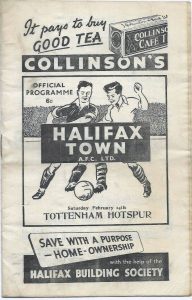
F.C. Halifax Today
The current incarnation began life in the Northern Premier League Division One North in 2008-9. They had a less than auspicious start soon climbed back up the divisions and are now established in The Conference (tier 5). They have twice lost out in the Conference promotion playoffs for a place back in the Football League. The most recent of these being in 2019-20.
They have also won the FA Trophy (the non-league version of the FA Cup) in 2016 so the new club does have a nice piece of silverware in the trophy cabinet.
FC Halifax still plays at their original ground “The Shay” (which they share with tie towns Rugby League side) and given it has a 14,000 plus capacity. So you should be able to turn up and pay at the gate unless of course, they are trying to emulate that fantastic 1950s FA Cup run.
The Best Shopping…
If you want some retail therapy or your better half is at the game then we have that covered too!
Arguably the best area of the city for shopping is the Halifax Borough Market. This place first opened its doors in 1896, before which most of the cities market trading was conducted out in the rain. If you want to sample local cuisine and English culture, this is the place you do it in. It is filled with local businesses so do spend some dough. If you like your stores a little more upmarket, then check out the Woolshops Shopping Centre of the Halifax Shopping Centre for kicks.
Where to Drink and Party in Halifax?
The Wainhouse Tavern is one of the oldest pubs in the city and mixes regulars with tourists to provide pints or snacks. It was built in 1877 and has been serving Halifax locals ever since. It’s always nice to eat and drink in a historical setting. If you are looking for somewhere to party the night away in Halifax try either Koko’s the cocktail bar, or ATIK for some dancing.
Other Notable Things to do in Halifax
We can’t cover every sight to be seen in historic Halifax, but we come as close as possible. Here are a few more places it might be worth visiting on your Halifax holiday:
- Head out to the Sowerby Bridge that crosses the canal and feed the ducks. Only don’t give them bread if at all possible. It is not good for them use proper duck food.
- The Calderdale Industrial Museum. Will give you a detailed look into the life of the clothiers of old-world Halifax. It’s another great day out for the little ones, which also helps them learn.
- You can find even more shopping at the Westgate Arcade if you aren’t tired out yet.
- Halifax steam Brewing Company is an adults-only tour experience worth indulging in.
- Visit the Dove Cottage Nursery and Garden for Springtime and Summer plants.
There is something to do for everyone in Halifax. Generations of people developing it has made it one of the best towns to call home in the UK. But if all you get to do is visit it for a fortnight or so, Halifax makes for an equally amazing staycation destination.
How to Get to Halifax?
We have mentioned all the things we can think of to do with Halifax – but we still haven’t told you how to get there!
By Road
Halifax is just off the M62 and can be reached by travelling south and east from Leeds.
On the Train
Halifax train station is on the Northern Line.
By Air
Your nearest airport is the Leeds Bradford International Airport and it is only 20 miles away.
Still Want More?
If you love reading articles about towns in England, then have no fear! We have you covered from London to Manchester. All it takes is a few selective clicks on our website and you can pick your new pet, learn about the legality of past actions, or even pick up a new hobby. At Five Minutes Spare we have a splash of everything, no matter what your tastes are.

